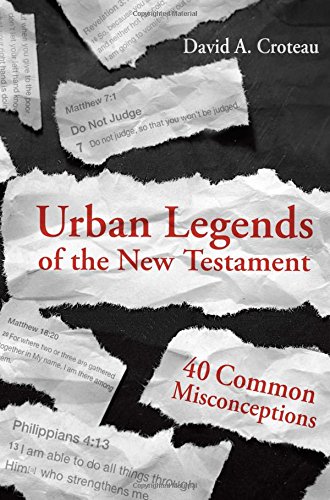Note: I received this book in exchange for a review here and at Arkansas Baptist News. So, here it is and then you should subscribe to the paper here. (or, if you are in an Arkansas Baptist Church, urge your finance committee to do the Every Resident Plan and keep your whole church up to date.)
Another note: I’m excited by books like this and a few others that you’ll see reviewed here eventually. We Baptists took a firm stand for the certainty of the Bible as inerrant several years ago, but in the process we slowed a bit on doing solid research and study. We are now finding our way back to doing real scholarship while holding to our convictions. Books like this are a product of that effort.
 Urban Legends of the New Testament by David A. Croteau, 255 pages, softcover from B&H Academic (sample chapter here)
Urban Legends of the New Testament by David A. Croteau, 255 pages, softcover from B&H Academic (sample chapter here)
Were there 3 Kings of Orient at the manger? Where was the manger, anyway? A cave, a barn, or somewhere else? These questions are among the 40 addressed in David A. Croteau’s Urban Legends of the New Testament, recently published by B&H Academic Press.
What is an “urban legend” of the New Testament? According to Croteau, it is a “commonly circulated myth, repeated throughout the culture as common knowledge, but which isn’t true.” (p. xiii) For the New Testament, this includes misunderstandings about the original culture of first century Israel as well as well-intended, but erroneous, explanations of Greek vocabulary. It is Croteau’s assertion that we who take the Bible seriously should also strive to get it right. We need to eliminate the urban legends from our teaching and preaching.
How is the book laid out? There is a prologue and an epilogue, explaining purpose, and then there are 40 chapters each addressing an urban legend. Sixteen are taken from the Gospels with the balance found in Acts, the Epistles, and Revelation. Each chapter follows the same format: an explanation of the legend, an effort to explain the origin of that legend, and the corrective prescribed from study.
The chapter titles themselves are more problematic than the material in each chapter. For example, one chapter addresses “Christians Are Commanded to Tithe” as an urban legend. The chapter itself, though, only speaks to one specific passage in Hebrews. The reader would be wise to examine the content of the chapters and not just judge by the headings.
Scattered throughout the book are QR codes which can be scanned with your smart phone. These link to videos of Croteau teaching on ten of legends mentioned in the text. If you are digitally inclined, these are of value. The prologue also provides a link for those who are not interested in using the QR system.
Each chapter features an annotated bibliography that references both print and digital resources. Some of the references are academic journals while others are books and blogs. Also commendable is the presence of footnotes.
In all, this is a useful reference book for preachers and teachers of the Word of God. At a minimum, it challenges the reader to correctly interpret and understand what is in the text. Highly recommended.


No comments:
Post a Comment
To deal with SPAM comments, all comments are moderated. I'm typically willing to post contrary views...but I also only check the list once a day, so if you posted within the last 24 hours, I may not be to it yet.